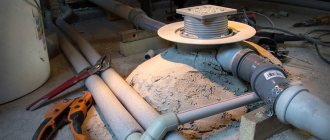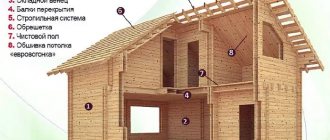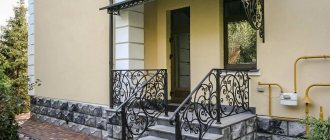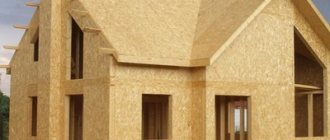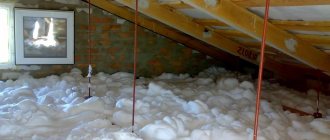Before implementing the wonderful idea of placing a sauna or steam room in the basement, you need to analyze how justified a bathhouse in the house is, the pros and cons of such a solution. The problem is much more complex than it might seem at first glance; in addition to purely construction problems, permitting issues will need to be resolved. First of all, this concerns fire safety and protection from possible negative factors associated with the proximity of the soil to the walls of the bathhouse.
Bathhouse in the basement
Undoubtedly, the layout of a bathhouse or sauna inside a residential building provides enormous advantages. In a classic building layout, a sauna or steam room is installed on the ground floor of the building or attached to a box in the form of a utility block. The option is quite reliable, but ineffective, since you have to give up valuable living space in the house for a bathhouse, or occupy the local area. Much more interesting is the scheme for moving the bathhouse to the basement of a private house. In this case, it becomes possible to save at least 20-25 m2 and at the same time insulate the basement of the building.
The prospect is tempting, but not everything is so simple. To arrange a bathhouse or sauna in the basement of a private house, you will need to solve quite complex problems:
- Waterproofing and insulation of the basement under the house, thermal insulation of load-bearing structures and ceilings;
- Combating high air humidity in the bathhouse, equipping with effective supply and exhaust ventilation;
- Equipment of the sauna or bathhouse premises with a special sewage system;
- A set of fire safety measures.
When building a bathhouse in the basement of a house, modern materials will be used for waterproofing and insulation, which either burn well or are capable of releasing toxic volatile substances during thermal decomposition.
Beautiful examples
- An excellent bathhouse made of natural wood, which is made in a minimalist style.
- A luxurious bathhouse in a large basement, which includes a relaxation area.
- Bathhouse with a separate shower room and shower stall. The lighting inside creates a unique microclimate and allows you to relax.
- Sources used in the article:
https://stroy-banya.com/karkas/banya-pod-domom-v-podvale.html - https://stroyday.ru/stroitelstvo-doma/pridomovye-postrojki/sauna-svoimi-rukami-v-podvale.html
- https://stroypomochnik.ru/banya-v-podvale-01/
- https://o-vannoy.ru/banya/vse-o-saunah-v-podvale/
- https://PlanVsem.ru/banya/banya-v-cokolnom-etazhe.htm
- https://poparimsya.online/stroitelstvo/banya-dom/podvale-sauna.html
- https://bouw.ru/article/banya-v-podvale-chastnogo-doma
High humidity
The first factor, not particularly dangerous, but extremely important, is the high level of air humidity. Any baths, both free-standing and inside the house, are built from materials that conduct water vapor well. Logs, bricks, foam concrete - in all cases, part of the moisture leaves the room through pores in the walls. Even if left idle for a long time, the sauna room sooner or later dries out to its natural humidity level.
If you build a bathhouse or sauna in the basement of a private house, the reverse process will be observed; a certain part of the groundwater will seep through cracks and pores in the basement walls. Accordingly, the premises of the steam room, dressing room, dressing room, if special measures are not taken, will be damp and cold.
Therefore, when planning a bathhouse in the basement of a house, you will need to do:
- Drainage of the foundation and perimeter of the basement walls;
- Apply insulation to the outer wall;
- Lay waterproofing of the floor, walls and ceiling of the future bathhouse.
For your information!
Depending on the method of finishing and heating arrangement of the sauna, internal insulation and cladding can be laid according to a ventilated or non-ventilated scheme. In the latter case, a space or gap 4-5 cm thick is left between the concrete basement wall and the insulation of the bathhouse or sauna, through which condensation and the remains of leaked groundwater will be removed from the sauna. Since the bathhouse in the basement will be located in an isolated space, without artificial supply and exhaust ventilation, the insulation and wooden cladding will quickly fail.
Device Features
Let's figure out how to reset all the disadvantages listed above. The easiest way to do this is to order a design for a bathhouse with a basement before the construction of the house begins. In this case, everything can be thought out and calculated in advance. It is more difficult to remodel an existing basement.
Waterproofing
There is a lot of water flowing in the bathhouse; protecting the walls, floor and ceiling from its effects is the most important task. As a rule, all these structures in the basement are made of concrete, which absorbs moisture well and retains moisture for a long time. You should safely isolate yourself from him.
For waterproofing, materials are used that do not emit harmful substances when heated. For example, liquid glass. All surfaces are thoroughly coated with it.
The floors of a house with a bathhouse in the basement require additional waterproofing from several layers of film and roofing felt under a cement screed.
Vapor barrier and insulation
The walls in the steam room and wash room need insulation. Moreover, the insulation must be moisture-resistant and environmentally friendly.
Note. Despite its resistance to moisture, polystyrene foam is not suitable for insulating a steam room. When heated, it releases harmful substances.
If the insulation material absorbs moisture, mold will soon settle in the basement. It is not only harmful to health, but also becomes a catalyst for the destruction of concrete structures.
The best ones for our purposes are:
- Mineral wool;
- Ecowool;
- Penofol.
The insulation is inserted into the cells of a wooden or metal frame and covered with a vapor-reflecting film. It is best to use foil with the obligatory sizing of all joints with foil tape.
When using foil penofol, this step is eliminated.
Frame with insulation
Next, a counter-batten is mounted on top of the insulation and vapor barrier, which will become the frame for the exterior finishing of the bathhouse in the basement of the house, and will provide an air gap between these layers. It is necessary for ventilation of the space under the cladding and rapid drying of moisture.
Ventilation
Humidity itself will not disappear; you need good air exchange in the room. Very good, since fresh air does not flow into the basement even with windows and ventilation holes; this is the most unventilated part of the house.
Forced ventilation is required with a constant flow of fresh air inside and removal of exhaust air.
For reference. In addition to humidity, harmful gases must be removed from the basement. In particular, radioactive radon released from the ground.
The ventilation of premises such as a bathhouse in a cottage on the ground floor should be designed by specialists.
There are different options and schemes for its design:
- With installation of a plinth deflector. This device provides the supply of fresh air in the required quantity, and the removal of gases and vapors to the outside. It is connected to a duct fan.
Photo of the outer part of the plinth deflector
- With supply and exhaust ventilation device. In this case, the hole for fresh air is placed in the wall next to the stove so that the air is immediately heated and does not cool the floor. And in the upper part of the opposite wall there is an exhaust hood. It is led out into a vertical channel ending above the level of the top floor.
Scheme of supply and exhaust ventilation in the bathhouse
It is important! Ventilation cannot be vented horizontally through the wall to the street, as this will cause backdraft due to low pressure in the basement.
It is also impossible for the bathhouse on the ground floor to have a common ventilation duct with the house, otherwise the humidity will spread throughout all the rooms.
Electricity supply
When installing electrical wiring and lighting, take into account the following rules:
- It is forbidden to place sockets and switches in the steam and washing compartments;
- They try to install all equipment in other rooms of the bathhouse closer to the floor, where the air temperature does not reach high values;
- All wiring must be done in an open manner, from above along the outer cladding. You can’t hide it under the finishing;
- The entire length of the wires is enclosed in a special corrugated tube - including in places where they pass through walls and ceilings;
- The lamps are also special, with heat-resistant and sealed shades.
If you do not have special education, you should not try to do this work yourself. It's better to entrust it to professionals.
Fire safety
The most difficult issue that one has to face when arranging a bathhouse in the basement of a private house with their own hands concerns the problem of fire safety. It is known that among outbuildings, fires most often occur in saunas and steam rooms. The reason is always the incorrect installation of the heater in the bathhouse or violation of the rules of its operation.
In conditions when the bathhouse is moved to the basement, the situation becomes even more complicated, primarily due to the requirements of SNiP and fire safety rules:
- Firstly, the rules of SP 4.13130.2009 prohibit the installation of heating devices operating on the basis of fuel combustion in basements. As an alternative, an electric boiler or steam-water heating registers connected to a boiler on the ground floor of the house can be used to heat a bathhouse or sauna in the basement;
- Secondly, for heating the steam room and the entire room, only certified industrial stoves and heaters with automatic safety and blocking devices can be used when the heating temperature reaches an excessive temperature;
- Thirdly, the design of the bathhouse must include a fire alarm, a fire extinguishing system and a fire-resistant door that allows blocking the flame front inside the basement.
In addition, the bathhouse must have an emergency exit, providing the opportunity to leave the premises in the event of a fire. It is clear that in order to obtain permission from the Ministry of Emergency Situations to install a bathhouse in the basement, it will be necessary to use non-flammable materials or special fire-retardant impregnations for wood for finishing.
Construction stages
When building a pool, it is important to consider the type of soil. If they are mobile - sand or sandy loam - the walls of the bowl are strengthened.
Work is carried out in a certain sequence:
- Marking the site and pit. These works are performed using a tape measure, level, poles and cord. First, the points at which the corners will be located are determined, then pegs are installed in the gaps - along the lines marked by the level. When marking the boundaries of the pit, take into account that between the walls of the building’s foundation and the bowl there should be 1.5-2 m, no less.
- Strengthening walls. The rabbeting method helps to strengthen the side edges of the bowl. This procedure is especially important on unstable soils. To complete it, you need a hand drill, concrete and reinforcement. 2.5-3 m long passages are drilled into the walls, reinforcement is placed in them and concrete is poured. This results in reliable reinforcement along the perimeter in the horizontal plane.
- Depreciation. The bottom and walls of the pit are first leveled with shovels and vibrating plates, then a layer of sand - 15 cm is poured into it. Having compacted the sand layer, crushed stone - 15 cm is poured into the pit and compacted.
- Waterproofing the bowl. Waterproofing is laid on top of the shock-absorbing cushion. Typically, bitumen-based coating mastics are used for this purpose.
- Walling. For this purpose, a variety of materials are used - concrete blocks, bricks, foundation wall blocks. At this stage, the walls are also waterproofed.
- Reinforcement. After the walls are erected, their rigidity, reliability and durability are increased using a steel frame. It is made of metal rods with a diameter of 10 mm and wire for the bundle. The rods can be connected in other ways, for example, by electric or gas welding.
- Pouring concrete. When doing the work yourself, first make formwork from boards, then prepare hydraulic concrete and pour it into the pit. Each layer of concrete is compacted to create a flat surface. If the work is carried out by specialists, at this stage they lay a concrete slab on the prepared bottom using special equipment.
- Installation of service systems. All equipment is installed in a technical niche constructed under the bottom of the bowl. It is sealed and closed with a hatch.
The room must be equipped with ventilation that controls air flow.
Bathhouse in the basement: advantages
For a sauna or steam room built on the base of a building, the safety conditions are not so stringent. Standards remain for the installation of fire-resistant doors; walls and partitions inside the bathhouse on the ground floor must be made of brick, concrete, or in the form of metal frame structures with fire-resistant backfill.
You can use stoves with a closed combustion chamber to heat the bath. In this case, the loading hatch of the firebox is moved outside the walls, into an extension to the house. A stainless steel chimney is laid along the outer wall, or discharged through the ceiling of the house, as in the diagram.
The height of the pipe must be at least 5 m above the level of the combustion chamber.
Often, home owners strive to build a basement version of a bathhouse or sauna. This solution provides high-quality protection of the foundation from frost heaving of the soil. In addition, a sauna box buried in the ground in winter is much more economical in energy consumption compared to free-standing baths.
According to SNiP rules, it is forbidden to store flammable objects and things in the basement; it is forbidden to arrange living quarters and rooms in which a person can stay for more than eight hours at a time. Therefore, installing a steam room will be the best solution to the problem of rational use of space. Good thermal insulation of the floor and walls of the sauna in the basement reduces heat loss through the ceiling of the first floor, and in addition, regular heating of the basement bathhouse dries the outer surface of the walls well and protects them from dampness and overgrowing with moss without any finishing.
For your information! A sauna in the basement of a private house is safer than a basement, since improved ventilation and the presence of windows seriously reduce the risk of radioactive radon accumulation.
Sauna equipment
An electric stove, preferably factory-made, is used as heating equipment, the power of which is calculated based on the volume of the sauna. For example, with a steam room volume of 20 cubic meters, the power of the heating stove must be at least 10 kW.
The equipment must be equipped with an automatic shutdown. It must be installed at a short distance from the floor surface - approximately 20 centimeters. For the stove, a fence is arranged around the entire perimeter so that the boards rise slightly above the stove, and the distance between them and the equipment is at least 5 centimeters.
Special stones for the sauna, which differ from each other in their characteristics and healing properties, will subsequently be placed in this space. The stones should heat up very quickly and retain heat for quite a long time, having a positive effect on the human body.
Natural stone heats up, reaching a maximum temperature, then, under the influence of water, local cooling of the rock occurs. Therefore, stones must be selected with high heat resistance, which will not crack or split.
In addition to the stove, lighting fixtures, thermometers for measuring the air temperature inside, an hourglass and ventilation valves, which are fastened with screws to the internal wooden lining, are installed in the sauna room.
For those who do not want to deal with the installation of a chimney, the construction of a heating stove with the laying of stones, we offer the installation of a ready-made infrared cabin.
Of course, it does not have a high steam temperature, and the depth of heating of the skin is also small. Infrared waves do not penetrate inside, and the skin dries out, which is not very favorable for its healthy condition.
Important. It is recommended to stay in the infrared cabin for no more than half an hour.
Don't forget to prepare material for the sauna
Sauna in the basement of the house: project
Traditionally, the basement area under the building is built over the entire area of the foundation. One of the layout options is shown in the project below.
In addition to a bathhouse or sauna, a boiler room or furnace room must be built on the ground floor; there may be a garage, a tool warehouse and a small recreation room. Small windows in the upper part of the relaxation room soften the cutting effect of artificial lighting well, so with proper equipment of a bathhouse in the basement or basement, the level of comfort is no worse than in ground-based steam rooms and saunas.
If you don’t want to bother with permits and fire safety permits, you can use the project shown in the diagram below to plan the room for a bathhouse and build partitions.
At first glance, there are not so many advantages from such an organization of the room; only a small part is used effectively, and even then, you have to steam in a sauna measuring 2x2 m.
There are no partitions in the basement, but there is a swimming pool, shower, washing machine and a place to relax. It is the absence of internal walls that provides the most important thing for a bathhouse located in a semi-basement - good ventilation, fresh air and enough space to participate in health procedures.
Monolithic pool
The main distinguishing feature of the monolithic version constructed in the basement is its heavy and durable structure, the construction of which requires a lot of effort. An important stage of construction is the calculation of the bearing capacity of the foundation.
Compared to frame pools, monolithic structures require more labor and money. The bowl can be finished using various materials, but the use of hydraulic concrete will remain unchanged.
The use of hydraulic concrete is due to the fact that it is waterproof. There are two options: make it yourself or order it from the factory. It is impossible to create concrete without a mixer, binder, filler and additives. This mixture, after hardening, becomes very dense, so it does not allow moisture to pass through. The following contents will improve the properties of concrete:
- ferric chloride;
- silicate glue;
- calcium nitrate;
- organosilicon water repellents.
For the composition to be optimal, it is necessary that the content of any of the above components is not less than 0.5 and not more than 1%.
In addition to the sealant, the composition should be diluted:
- modified calcium oleate – ceresite;
- sodium oleate;
- sodium abietate.
As a result, the developer should get a mixture that, after hardening, has the properties of class B25 concrete, frost resistance F200, and water resistance w8. To do this, it is necessary to use 490 kg of cement grade M400, water in the amount of 202-205 liters, a ton of crushed stone with medium-sized fractions, 0.5 tons of sand, superplasticizer S-3 1.5 kg. In addition, 5 kg of sealant and 1 kg of water repellent.
Planed and unplaned boards, OSB sheets, and plywood are suitable as formwork materials. But it is best to use plastic or metal formwork. Some construction organizations rent out these elements for the construction of a swimming pool.
Construction of a sauna in the basement
When arranging a bathhouse in a basement or semi-basement, first of all you need to take care of wall insulation and waterproofing. The primary layer of expanded polystyrene and roofing felt are laid around the perimeter of the outer surface of the walls.
This is followed by the application of a coating waterproofing mastic inside the future bathhouse. After the insulation layer has dried, they proceed to installing load-bearing sheathing on the basement walls, which will hold the thermal insulation and lining of the bathhouse.
It can be made from a galvanized profile or wooden slats; wood can be used for sheathing in the basement without restrictions, provided it is impregnated with silicone fire-resistant varnishes or fire retardants.
In any case, there must be an air gap between the wall and the layer of mineral insulation. The ceilings and floors of the bathhouse are made in a similar way. The laid insulation is laid with a vapor barrier and sewn up with finishing material. OSB-3 boards, which have high strength and are resistant to water and open flame, are traditionally used as a rough covering in the basement.
Do-it-yourself pool finishing
Finishing the bottom and walls of the pool can be done in several ways. The simplest is plastering followed by painting. But such bowls are less aesthetically attractive than those decorated with ceramic or porcelain tiles. The most effective mosaic in a pool is that it provides a play of light and shadow as the water fluctuates.
There is also a finishing method such as covering the bowl cavity with PVC film. But this method has many disadvantages, including the fragility of the facing layer. In addition, covering with PVC film is only suitable for small-sized structures.
The bottom of the tank is at a depth, so a ladder will be needed to perform finishing work. The lining of the bowl begins after installing the equipment necessary for filtration. If you choose ceramic tiles or mosaic finishing, you will need: glue, tape measure, mallet. Laying of facing material is carried out with regular checking with a bubble level.
If you decide to plaster the bowl, choose cement-based compositions. Gypsum plasters are hygroscopic and are not suitable for finishing swimming pools.
Ventilation and sewerage
The second most important element of a sauna is the ventilation and ventilation system. For a bathhouse located below ground level, an exhaust air exchange system is used. This means that overheated and over-humidified air is removed through a ventilation pipe in the corner of the ceiling.
In a small sauna, it is enough to install one exhaust shaft to ventilate the gap between the walls and the insulation and two pipes for the interior of the bath. One of the vertical air ducts is located in the steam room, in the area of the shelves. Thanks to the exhaust pipe, part of the superheated air from the stove enters the sauna steam room in the shortest possible way and heats the shelves to 60-70 ° C.
In full-size saunas, ventilation ducts and ducts are hidden behind the ceiling sheathing and connected to a centrifugal fan located in a moisture-free area of the basement.
To remove dirty and waste water in the bathhouse, special collection containers are used, from which the collected material is discharged outside the basement.
Sequence of work
We will now tell you what, why, and how to do it when setting up a steam room in the basement. But first, watch the video: “Baths in the basement.”
Walling
To fence off a bathhouse, you will need to build a maximum of two walls (and most often one), since the rest are already there - these are the foundation walls. And inside the enclosed space, according to the layout, partitions are installed from a wooden or metal frame sheathed on both sides.
Installation of partitions
Laying insulation
Hidden laying of communications
The same frame is mounted on external walls for thermal insulation. If plumbing, ventilation and sewerage will be laid secretly, then they will be installed immediately after assembling the frame.
Advice. It is better to make the partition between the steam room and the dressing room around the stove from bricks or other non-combustible building blocks. It is connected to the main walls using reinforcement or metal brackets.
The photo shows reinforcement driven into the wall, the end of which will be embedded in the masonry
Floor installation and sewerage installation
Before pouring the floor in the washing room and steam room, you need to solve the problem of drains:
- If there is such a possibility (for example, if the house is located on a site with a good slope), make a gravity sewer. To do this: dig a trench on a slope from the washing area towards the site, and lay sewer pipes in it with outlets at the wastewater collection points. The end of the pipe is led into a common septic tank with the house, or outside the site.
Gravity water drainage scheme
- If the bathhouse with a basement is located below the level of the house’s sewer system, you will have to install a special pump that lifts the wastewater from the lowest point into the house system or into a separate storage tank. From there they can be sent by gravity to a treatment plant, septic tank or central sewage system.
Scheme of forced sewerage from the basement
- Filling the floors in the steam room and washing room begins after waterproofing the base and laying the sewer pipes.
- They are covered with roofing felt, covered with a layer of gravel on top and a cement screed with the addition of liquid glass is arranged.
- After the screed has dried, the procedure is repeated, but the screed is reinforced with mesh.
It is important! Sewage pipes are laid taking into account the thickness of the future screed. And the floors are poured with a uniform slope towards the drain.
Heating
Even before pouring the floor, you need to think about where the stove will be located, and what type and size it will be. If the firewood is brick, then a separate foundation is poured under it, not connected to the foundation of the house. The foundation cushion around the perimeter is made 5-10 cm larger than the dimensions of the stove.
Foundation layout diagram
Advice. By placing the stove so that the firebox opens in the dressing room and the heater is in the steam room, you will not have to conduct heating into the dressing room.
Optimal location of the stove
Particular attention to the chimney. Several options are possible:
- If a bathhouse in the basement is designed together with the house, the stove is immediately provided with its own chimney, passing through the wall of the building or through the rooms located above.
- Installation of a separate chimney, located on the facade and raised above the house. It must be insulated or a sandwich pipe with a thermal insulation layer must be used.
External chimney
- Using a chimney from a home heating boiler, if its parameters allow such a connection. In this case, the options for the location of the sauna stove are limited.
Combining two chimneys into one
- Using an electric stove, which does not require a chimney at all. But the electrical network must have sufficient power to withstand a serious load.
A bathhouse on the ground floor with an electric stove is much safer than with a wood stove.
The remaining rooms of the bathhouse complex can be heated from the house. Or hang electric convectors, which, by the way, will additionally dry the air.
Finishing and arrangement
You can install your own boiler for hot water in the bathhouse, but it can also be removed from the house if the power of the home heater is sufficient.
You can also install a large container on the chimney in which the water will be heated from the pipe. But this is an option for everyone.
Hot water tank
When the stove is installed and all the main communications are installed, you can begin finishing:
- Walls and ceilings in rooms with high air temperatures are sheathed with wooden paneling made of larch, linden or aspen. Leaving at the same time gaps of several centimeters at the ceiling and floor for air to enter the ventilation gap between the cladding and the insulation.
Cladding the ceiling of the walls with clapboard over insulation with penofol
- The frame for shelves and benches can be made of pine or spruce, but it also needs to be lined with deciduous wood, since coniferous trees release resin when heated.
- Wooden gratings and ladders are laid on the floor in the steam room and washing area. In other rooms the coating can be made continuous.
- After finishing, electrical wiring is carried out on top of the cladding, switches, sockets and lamps are installed.
Further improvement is a matter of taste and financial capabilities. You can simply hang a mirror and put a table with benches in the dressing room. Or you can equip a comfortable kitchen, a billiard room, and install a swimming pool. Stylistically, solutions can also be different. Here are some examples:
Comfortable relaxation room in front of the sauna in the basement
Dressing room with kitchen in eco-style
Hot tub in the recreation area
Very nice budget option
Sewage disposal system
Removing dirty water at the end of bath procedures is not as simple as it might seem at first glance. The reason is obvious - the basement itself is located below the level of the sewer pipes and drains of the house.
Therefore, all wastewater in the basement is collected in a sealed tank or cistern connected to the sewer riser of the house at the level of the first floor. An air compressor is connected to the container with waste water; after turning it on, excess air pressure forces the collected liquids into the general sewer system of the house.
Sometimes bathhouse owners take a more expensive and reliable route; instead of a compressor, a submersible fecal pump is installed in a collection tank in the basement subfloor, capable of pumping the contents directly into a septic tank or cesspool.
Disadvantages of a swimming pool in the basement
Although you won't have to think about add-ons or heating, you will need to organize many additional systems. For example, you will need high-quality ventilation, overflow tanks, drainage, etc.
Also worth noting:
- High humidity. The basement will need high-quality waterproofing. Otherwise, the artificial pond will become a source of mold and mildew.
- Often the pool is located asymmetrically in the basement. This leads to the fact that the foundation is not strengthened, but experiences increased loads. It may get to the point where the so-called folding of concrete strips occurs.
- If the soil breaks below the level of the slab or foundation support, then there is a risk of losing the stability of the foundation of the house. Therefore, you should not try to destroy the pool, which will be part of the foundation. It must have its foundation.
- At the excavation preparation stage, there is a serious risk of damage to the walls of the house. In the saddest situations, houses are simply piled into pits.
These are quite serious disadvantages. In addition, not every type of artificial reservoir can be installed in a used house.
Bath drainage system
Upon completion of the bath procedures, the problem arises of how to remove the remaining humid air and traces of condensation from the basement. If this is not done, then most of the water vapor will settle on the insulation and condense on the floor and ceiling of the sauna.
There are two schemes for the bathhouse drainage system. In the first case, for small saunas, the heat of cobblestones laid on the grid of an electric heater is used. The heat reserve of the stone heated to 150°C is enough to dry the steam room of the bathhouse, most of the walls and the washing tray. To speed up the process, an inlet window for fresh air is installed in the basement, next to the heater.
For large sauna rooms, a heater is clearly not enough, so to dry the basement, they use forced supply and exhaust ventilation. Most of the air enters through cracks in the basement flooring and is exhausted through the exhaust pipe.
If the size of the sauna in the basement does not exceed 10 m2, a conventional fan heater mounted in the lower part of the coldest wall of the sauna can be used as a dehumidifier.
Water filtration
In most cases, skimmer filtration systems are used. The main working device collects the top layer of water, where there is usually the most dirt. The system has a fairly high efficiency when cleaning large elements. Its main disadvantage is that purified water flows back into the pool. Water returns to the system through holes in the walls.
There are also overflow filtration systems, but they are very rarely used in the basement. This is due to the complexity of the design and the need to create large reserves of space in depth and width, which may simply not be enough in cramped conditions.
Heating
The heating system for a bathhouse in the basement can be divided into two independent circuits. The first is used for general heating of the sauna, providing hot water for the steam room and shower. For these purposes, a double-circuit gas boiler installed in the utility room of the first or basement floor, outside the bathhouse, is ideal.
If the house does not have water heating, then to heat the basement you can use an industrial solid fuel boiler with automation and a built-in heat exchanger. In any case, the source of hot water should be installed outside the basement and bathhouse.
The second scheme is used to heat the sauna. In this case, only a factory-made electric heater should be used for the basement. The wiring for connecting the electric heater is laid behind the wall cladding, always in asbestos or fiberglass sleeves. Metal or plastic corrugations cannot be used. The heater must be equipped with grounding and UDO, the control panel is mounted on the wall at the entrance to the steam room of the bathhouse.
According to the conditions of SNiP, an electric stove for a bath in the basement must be equipped with an automatic shutdown when the maximum temperature reaches 150 ° C and a timer that de-energizes the heater after 8 hours of continuous operation.
Electric heating or wood?
It is not easy to answer the question: what type of stove to choose for a home bath in the basement. First of all, because it is very difficult to define specific criteria that would allow such an unambiguous assessment. Even if we take into account energy efficiency, cost or ease of use, this comparison can only be made on individual models representing a given type of heating.
What to consider when choosing stove types
| Varieties | Peculiarities |
| Single-component electric furnaces. | Dry sauna stoves, in which we pour water (usually with the addition of essential oils) onto heated stones to obtain higher humidity. |
| Electric dual-function ovens. | This is a stove with an evaporator (for example, from the Bi-O series), which will fill the bath with dry, humid air or steam. |
What to choose? The answer usually lies in the preferences of the person planning their own home bath in the basement. In technical questions regarding the possibility of using specific stove models in rooms intended for bathhouse needs, it is worth consulting with production and assembly specialists.
Materials for arranging a home sauna
As with most above-ground bathhouses, linden and aspen lining is used to line the steam room in the basement. Usually masters do not want to use fire retardant impregnations in the sauna, considering them harmful, but in vain. This coating increases the ignition temperature of the wooden cladding of the bathhouse walls from 180°C to 310-350°C. Otherwise, the fire inspector will be forced to install a dry pipe fire extinguishing system in the sauna.
To finish the rest of the walls of the bathhouse in the basement, OSB, waterproof plywood and plasterboard are used. The shower section in the sauna, if there is no cabin, is tiled. Apart from impregnated wood and mineral materials, nothing can be used to finish the walls in the basement.
To insulate a bath, two types of materials can be used. In the first case, the ceiling, walls and floor of the sauna can be insulated with special heat-resistant PBS-S foam, provided that the sheets of material are covered in the basement with cement screed or ceramic tiles.
In the second case, the insulation of the walls and ceiling is carried out with mineral wool with a two-layer patch of waterproof plasterboard and tongue-and-groove strips. Such a sandwich is not afraid of moist hot steam and at the same time protects the basement thermal insulation layer well from condensation.
Steam room assembly
After determining the location of the sauna and making an individual project, they begin to assemble the steam room. According to sizes:
- vertical and horizontal bars are installed;
- all corners of the structure are checked;
- outside the frame, the walls are sheathed with sandwich panels, clapboard or plywood;
- Insulation is laid on the inside, and a vapor barrier layer is placed on it;
- all joints are carefully covered with foil tape;
- internal walls are sheathed with longitudinal or transverse slats made of non-coniferous wood;
- similar actions are performed with the ceiling;
- the floor inside is covered with ceramic tiles, on top of which a grating is installed so as not to burn your feet;
- build two shelves for a comfortable position while sitting or lying down;
- a stove (floor or wall) is installed with an enclosing structure.
When assembling the steam room, do not forget to follow the instructions
Installation of a sauna stove
The most basic structure in a bathhouse is, of course, the stove. Usually they rarely make it with their own hands, but buy a ready-made version. This is because modern technologies make it possible to create very efficient and inexpensive stoves that, even in the basement, will quickly warm up the room and make it a full-fledged steam room.
But besides the purchase, it is also very important to install the stove. If it is installed incorrectly, it will have little service and efficiency will be low. The work is carried out according to the following scheme:
- We are digging a pit specifically for installing the stove. It should be 30-35 centimeters larger in size than the stove and must be at least 20 centimeters away from the wall.
- Crushed stone is placed at the bottom of the pit and compacted. Then everything is poured with concrete.
- The stove must be installed in such a way that the ventilation pipe goes out into the hole in the roof, and there is a place for storing firewood in the dressing room.
If you build a bathhouse with your own hands in the basement, it is better to use ceramic ducts for ventilation. They are more expensive, but will help retain heat in the house and reuse it to heat living spaces.
Building a sauna together with your home is a simple but very effective method of saving money on construction, as well as subsequently saving on heating the entire house. You won’t be able to build such a room for a large company, but it’s a very good option for a vacation for the whole family. Moreover, now there are a lot of interesting projects that almost everyone can implement.




